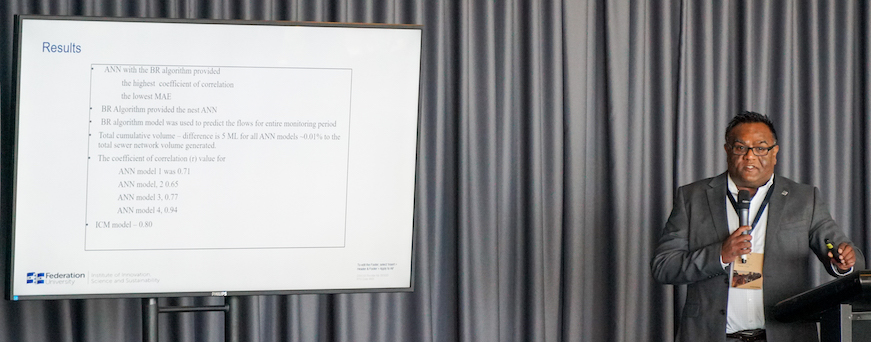& Construction

Integrated BIM tools, including Revit, AutoCAD, and Civil 3D
& Manufacturing

Professional CAD/CAM tools built on Inventor and AutoCAD
3 min read
Data, predictive modelling, AI, automation, and other digital technologies are providing solutions to the biggest challenges facing Australian water utilities, ensuring their assets and communities can remain safe, efficient and cost-effective.
At Autodesk Digital Water Day, held in November 2022 in Melbourne, leaders from across the water sector explored the impact of digitisation and exactly how digital transformation can lead to safer, reliable and more efficient operations.
The gathering covered a range of topics Autodesk’s partners and customers’ case studies, from modelling for water quality to digital twin maturity levels, and how Autodesk’s digital solutions can help reduce costs, materials and carbon emissions for utilities.
Mahinda Jayasooriya, PhD Candidate from Federation University, explored a local case study from a Ballarat sewer network in Victorian Highlands to explore how data-based modelling can be used to predict sewer network flows. Jayasooriya explained how Artificial Neuron Networks (ANN) with a variety of input parameters provided the most accurate correlation to observed data.

Mahinda Jayasooriya explains how Artificial Neuron Networks (ANN) with a variety of input parameters provide the most accurate correlation to observed data.
“Utilities need to think out of the box and find out the different ways of doing things,” said Jayasooriya. “The problem is the lack of awareness of the products and its wide range of applications. We need to increase communication, shared knowledge, and customer focus within utilities.”
The study confirmed that data-based modelling is an effective sewer network flow prediction tool compared to physics-based modelling.
Representatives from Stantec and VAPAR reiterated this sentiment, emphasising how large-scale digital solutions can be broken down and implemented through various AI tools, network models, digital twin structures, operational simulations, and risk assessments.
VAPAR Business Development Manager Mark Lee continued the discussion with a talk about how Rotorua Lakes Council in New Zealand has addressed a number of critical pipe condition challenges. Using AI technology and automation, they were able to streamline the pipe condition workflow by recording sewer pipe inspections, analysing defects, and integrating this data into their strategic asset management planning.
In his presentation, Lee emphasised how rural and regional communities like Rotorua are often looking for options to become proactive and more efficient in order to optimise asset renewal budgets. Using data analytics and digital solutions, these organisations can improve risk management and repair prioritisation that help prevent future failures, not only protecting businesses and utilities, but the health and safety of local communities.

“Consistency in data is crucial, continued Stantec’s Graduate Civil Engineer Evan Bywater. “Models are built on data, and so they can only be as strong as the reliability of their data input.” This has been demonstrated in Wodonga, a fast-growing regional city with potential for synergies in infrastructure which can provide water and wastewater solutions for the community, through the combined delivery of its water and sewer master plans.
Justin Hanson, Director at Digital Water Solutions, expanded on this with a presentation on how mature digital twins can benefit businesses’ sustainability, collaboration and operational efficiency. “It can be a little daunting to move towards digital twins. We can break up that process into bite-sized pieces and progress along the journey, and do it in a structured way so that the community, environment and our stakeholders can reap the benefits.”
Hanson said some of the most common challenges businesses face when implementing digital twins include not having executive buy-in, the need for additional stakeholder engagement, process re-engineering, fit-for-purpose visualisation, and the ongoing support and maintenance of digital twins.
The big takeaway from this event that was expressed by nearly all of the presenters: Australian utilities should move delibarately and quickly to digitise their operations so that their businesses can remain proactive in their system oversight to avoid challenges that can lead to increased costs, resources, and emissions.
Sign up for the One Water Blog newsletter, and we'll keep you updated about our top stories, along with the best content we find online. We only send out a newsletter when we have something interesting to share.
May we collect and use your data?
Learn more about the Third Party Services we use and our Privacy Statement.May we collect and use your data to tailor your experience?
Explore the benefits of a customized experience by managing your privacy settings for this site or visit our Privacy Statement to learn more about your options.